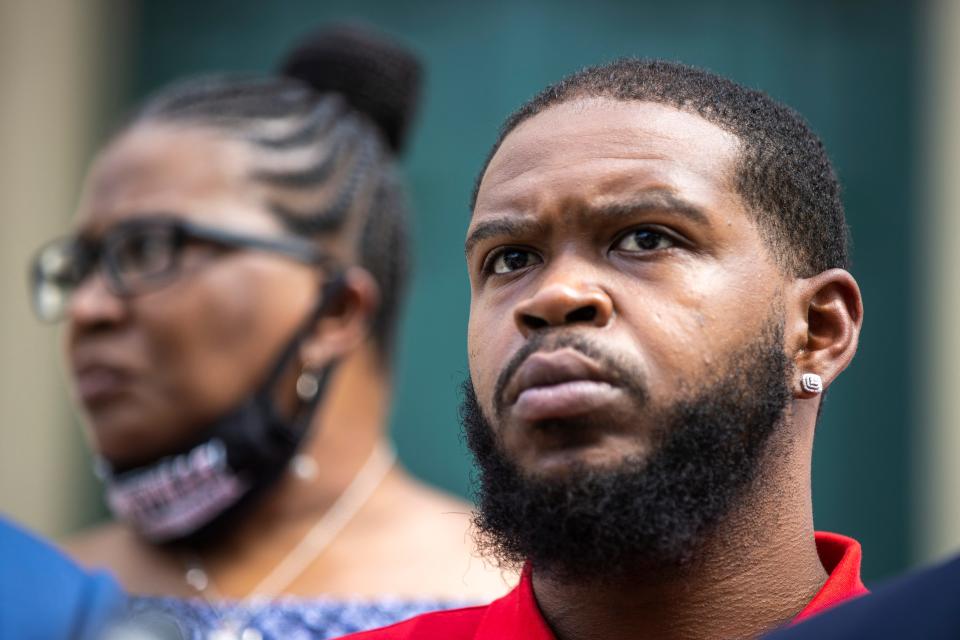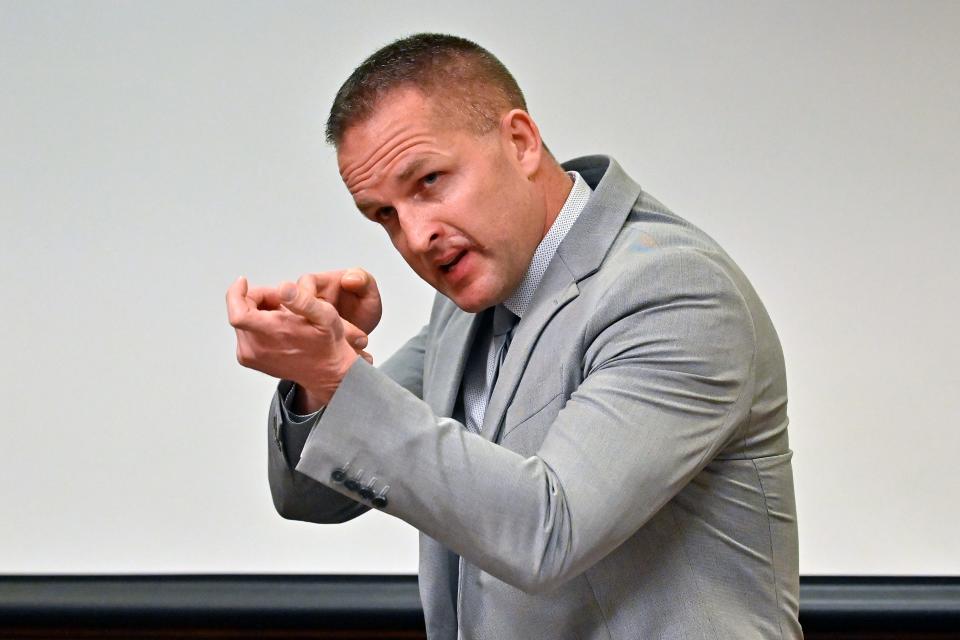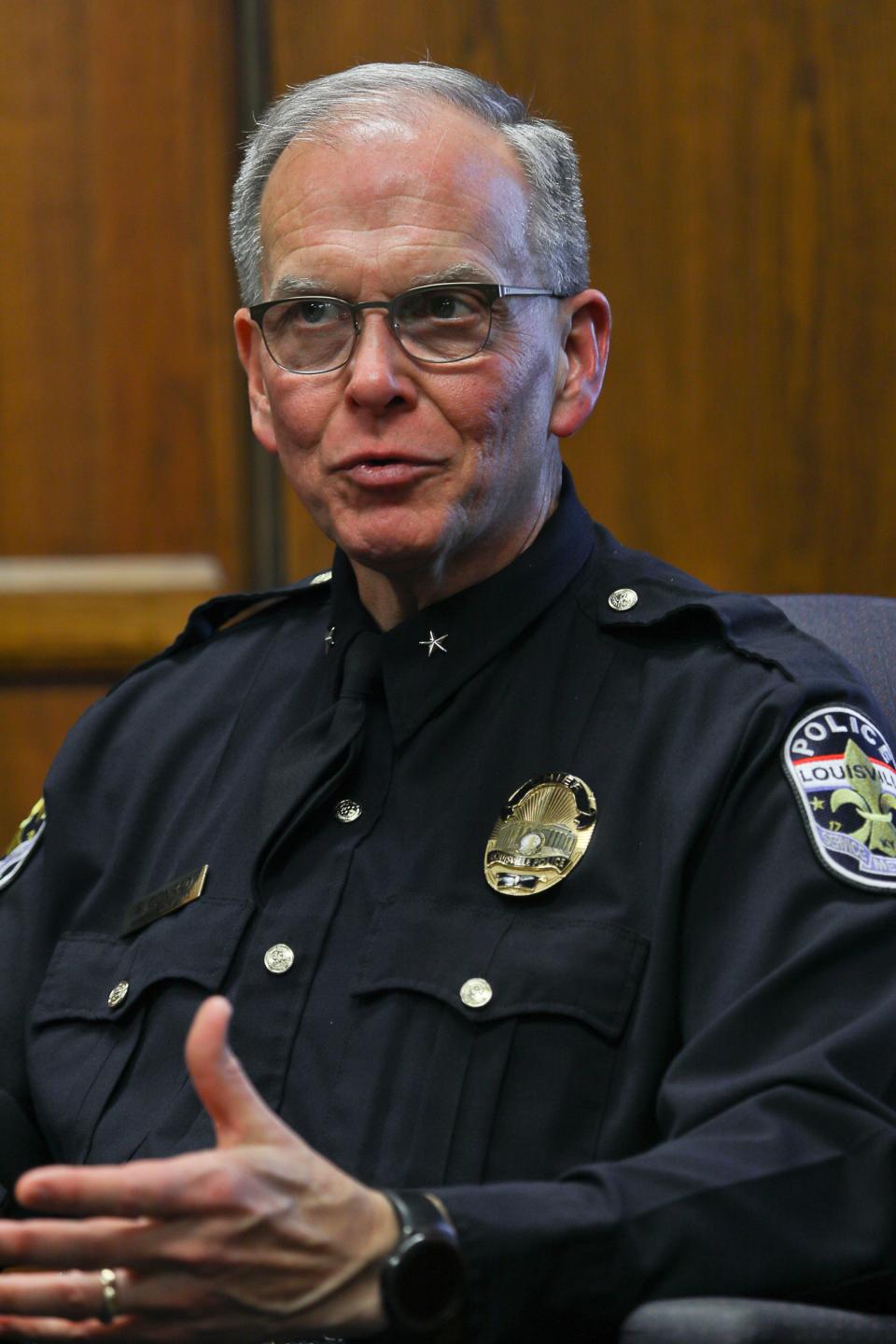Prosecution rests in Brett Hankison civil rights trial. Here's what key witnesses said
After several days and over two dozen witnesses, the federal trial of former Louisville Metro Police Detective Brett Hankison, who is facing charges he violated the civil rights of Breonna Taylor, her boyfriend and three neighbors during the police raid that killed her, is soon arriving at a close.
Taylor, a 26-year-old emergency room technician, was inside her South End apartment when she was fatally shot by plainclothes officers attempting to serve a search warrant at 12:40 a.m. March 13, 2020, as a part of a botched narcotics investigation.
Though seven officers were on scene to serve the warrant, only three fired their guns: Sgt. Jonathan Mattingly, Detective Myles Cosgrove and Hankison. They fired a combined 32 rounds throughout the apartment, but Hankison fired 10 bullets through a covered sliding-glass door and window. The government accuses him of using excessive force.
The prosecution rested its case Wednesday, while the defense plans to have Hankison wrap up his testimony on Monday. Closing arguments are expected early next week.
Here's what some key witnesses have said:

Kenneth Walker, Breonna Taylor's boyfriend: 'It sounded like an explosion'
During his testimony, Kenneth Walker said he has thought about his former girlfriend, Taylor, and her shooting every day since that night.
Walker told the jury his experience of that night, with him and Taylor waking up to loud bangs on the front door. Walker said he and Taylor asked three separate times for the people to identify themselves but heard no response. He believed it to be a break-in, Walker said.
While Walker and Taylor got out of bed and moved toward the apartment's entrance, the front door burst open.
"It sounded like an explosion," Walker said, adding he felt terrified.
Walker then fired one round from his handgun, with his bullet striking Mattingly in the leg. Mattingly would later require surgery to repair his femoral artery.
Mattingly, Hankison and Cosgrove would proceed to fire their weapons. Taylor was struck six times and died in the hallway. The coroner's office listed her time of death as 12:48 a.m.
Cody Etherton, one of Taylor's neighbors, also recounted being awakened in his bed by a loud boom and subsequent rapid gunfire. As Etherton got out of bed and walked down his hallway to go toward the front door, he said bullets began flying through a common wall shared with Taylor's apartment.
Drywall, debris and dust hit his face as he immediately dropped to the ground and yelled for members of his family to get down as well.
Etherton has a pending federal lawsuit against LMPD and Hankison over the raid.
After the gunfire ceased, Etherton said he remembered hearing a distraught voice from Taylor's apartment, pleading with someone to "breathe, Baby, breathe."
Witness on scene of fatal shooting changes testimony
Aaron Sarpee, who was at the apartment complex to pick up his child from one of Taylor's upstairs neighbors, testified his experience of that night.
Officers on the scene to serve the warrant, such as Mattingly and Hankison, have said the group announced themselves as police several times while repeatedly knocking on the door before ramming the front entrance open.
During previous grand jury testimony, Sarpee said he heard LMPD officers announce themselves at the point he stepped onto an exterior staircase. He initially told police he didn't hear any such announcement, but the grand jury was told Sarpee had a "language barrier" and seemed confused by the questioning.
But testifying in the federal trial, Sarpee said he did not hear LMPD officers announce themselves as police before the front door was breached.
A federal prosecutor had Sarpee explain he is a veteran with PTSD, which can affect his memory.
Mattingly describes 'barrage of gunfire'
On the stand, Mattingly described knocking on Taylor's door and then being dragged away by fellow officers with a critical injury during rapid gunfire.
Mattingly said, prior to breaching Taylor's apartment, officers announced themselves several times and knocked aggressively on the door for "45 seconds to a minute." This was significantly longer than normal when serving a search warrant, with a typical announcement only lasting about 10 seconds.
Once the door was open, Mattingly recalled seeing a muzzle flash from a handgun and being struck by a bullet. He said he was soon able to get out of the area with the help of fellow officers.
While he was escaping the exterior breezeway area, he said he could hear echoes of gunfire from Cosgrove, who was still near the apartment's entrance. He then heard a "half a second" pause before hearing open air shots somewhere along the exterior side of the apartment.
Prosecutor Michael Songer brought up prior testimony from Mattingly, where he said he couldn't tell whether those shots were from out in the parking lot or closer to the building. In his current testimony, Mattingly said those open air shots did not come from the parking lot.
Mattingly said it was a couple of shots that lasted a few seconds. Songer said Mattingly's previous testimony described it as a "barrage" of gunfire.

SWAT team member: Hankison appeared to be boasting at scene
Several current and former LMPD officers were called to the stand, including Cosgrove, who fired the bullet that killed Taylor.
During his testimony, Cosgrove said Hankison was firing his weapon from the parking lot after other officers had already ceased firing and moved away from Taylor’s front door. He called Hankison's conduct “unfathomably dangerous.”
The jury has heard from at least four other current or former LMPD officers who said they would not have fired into Taylor's apartment window and glass door, which they said were covered and provided no view. According to these officers, it is against LMPD policy and training for an officer to fire their weapon if they do not have "positive target identification," where they can clearly see an imminent threat to human life.
Chris Kitchen, who served on LMPD's SWAT team and responded to the scene, said he remembers seeing Hankison in the parking lot with other officers after the gunfire ceased. Kitchen said Hankison was bouncing up and down, pointing at his chest and then gesturing to the curtained glass door and window.
Kitchen said it seemed like Hankison was boasting.
During cross-examination, Hankison's defense counsel asked whether Hankison's body language, such as bouncing up and down, could be an adrenaline response to an intense situation. Kitchen answered it could have been.
During a chaotic scene like this, police are trying to figure out what happened, Hankison's defense team said, which would make Hankison's actions that night simply sharing more information.
In another witness testimony, Lt. Dale Massey, a member of LMPD's SWAT team at the time, said he also saw Hankison point at his chest and gesture to the area of the window and sliding glass door.
His defense team asked if it was possible Hankison was "taking accountability" for the rounds he fired, to which Massey agreed.
When prosecutor Michael Songer asked what Massey's reaction was upon learning that an LMPD officer had shot through the curtained window and sliding glass door, Massey replied it was "complete and utter shock and disbelief."
Massey later added: "You can’t shoot at what you can’t see."
Defense attorney Jack Byrd said Massey did not know what Hankison saw or heard that night.
At the time of the shooting and in a subsequent interview with investigators, Hankison said he saw an AR-15 rifle and the muzzle flashes from it. He knew another officer had been shot and believed they were being "executed," he said.
No rifle was found at the scene. Only one gun - a handgun owned by Walker - was recovered.

Fired Chief Steve Conrad speaks on deadly force
Former LMPD Chief Steve Conrad testified about LMPD's use of deadly force policy and training, saying "police officers are not immune to charges" if they misuse their weapons.
Conrad, who served as LMPD chief for eight years, faced increasing public pressure shortly after Taylor's shooting, eventually announcing two months later that he planned to retire at the end of June. A month later, he was fired effective immediately by then-Louisville Mayor Greg Fischer after he learned officers at the fatal shooting of popular eatery owner David McAtee did not have their body cameras turned on.
"Deadly physical force was something that we did not take lightly," Conrad said.
While it is "something we hope and pray that we never do," there are situations where it is necessary, Conrad added. Deadly force should only be used when it is to protect the officer's life or another person's life.
Conrad also said, before firing their weapon, the police officer needs to be able to clearly see the threat and consider the safety of innocent people around them.
During cross-examination, defense attorney Jack Byrd called attention to the exact wording of LMPD's policy for justification of deadly force, which includes "facts known, or perceived, by an officer."
In redirect, Songer affirmed the officer's perception needs to be considered reasonable. He then asked whether officers are allowed to shoot a person they cannot see, to which Conrad said no.
Hankison's defense began its case Wednesday afternoon.
More: FACT CHECK 2.0: Separating the truth from the lies in the Breonna Taylor police shooting
This article originally appeared on Louisville Courier Journal: Brett Hankison trial: Breonna Taylor's boyfriend, ex-chief testify

